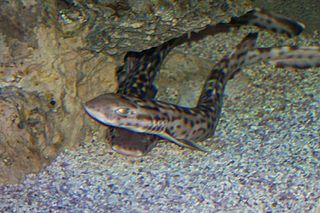
Atelomycterus is a genus of catsharks in the family Scyliorhinidae.

The Australian marbled catshark is a catshark of the family Scyliorhinidae, found in the eastern Indian Ocean, endemic to Western Australia between latitudes 12 and 21°S, from the surface to 245 m (800 ft) deep. Its length is up to 60.0 cm, and it typically inhabits coastal waters with sandy or rocky bottoms.

The coral catshark is a species of catshark in the family Scyliorhinidae. It is common on shallow coral reefs across the Indo-West Pacific, from Pakistan to New Guinea. Reaching up to 70 cm (28 in) in length, the coral catshark has an extremely slender body, a short head and tail, and two dorsal fins that are angled backwards. It can be identified by the numerous black and white spots on its back, sides, and fins, which often merge to form horizontal bars. Furthermore, adult males have distinctively long and thin claspers.

The banded sand catshark is a catshark of the family Scyliorhinidae found in the Indo-West Pacific Ocean, endemic to northern Australia between latitudes 10° S and 21° S, at depths between 27 and 120 metres. Its length is up to 45 centimetres (18 in). They were the first sharks to be discovered living in sponges.

The Bali catshark is a species of catshark, belonging to the family Scyliorhinidae, found only off the Indonesian island of Bali. It can grow up to 47 cm (19 in). Atelomycterus baliensis inhabits the deep coastal waters of Bali, Indonesia, feeding on small fish and invertebrates.
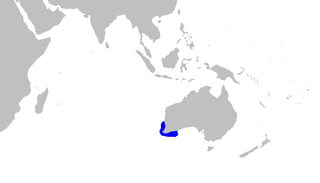
The Australian blackspotted catshark is a catshark of the family Scyliorhinidae in the order Carcharhiniformes.
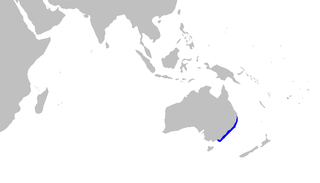
The Australian spotted catshark is a catshark of the family Scyliorhinidae, found only around Australia between 32 and 38°S, at depths between 10 and 180 m. It can grow up to 90 cm. Females of this species were observed as being reproductive year round. They are also confirmed as being a single oviparous species.
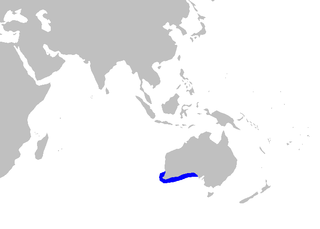
The western spotted catshark is a cat shark of the family Scyliorhinidae found only around southwestern Australia, at depths between 100 and 400 m. Males can grow up to 60cm in length, while females have a maximum length of 53cm. The western spotted catshark reproduces via oviparity.

The orange-spotted catshark or rusty catshark, is a species of catshark, and part of the family Scyliorhinidae. It is found only off the coast of Western Australia, at depths between 25 and 540 metres. Its length is up to 39 centimetres (15 in).
The Arabian catshark is a catshark of the family Scyliorhinidae. It can grow up to 30 centimetres (12 in) long, and lives in open seas. It is only known from a single specimen, now lost, which was found on the continental slope of the Arabian Sea.

The shortnose demon catshark is a catshark of the family Scyliorhinidae found only in deep water in the East China Sea. Its length is up to 40 cm. A. internatus is known only from the holotype and a paratype, both caught in the East China Sea, probably taken as bycatch in deepwater trawl fisheries. The reproduction of this catshark is oviparous.

The South China catshark is a catshark of the family Scyliorhinidae, known only from the holotype, which was taken from the South China Sea at a depth of 537 m. Its length is 42 cm, but this measurement was taken from an immature specimen. The reproduction of the South China catshark is oviparous.
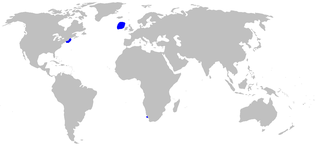
The ghost catshark is a catshark of the family Scyliorhinidae found on the continental slopes in the northwest Atlantic off Massachusetts, the northeast Atlantic from the Porcupine Bank west of Ireland and the southern Atlantic off Cape Town, at depths between 600 and 1,900 metres.
The black roughscale catshark is a catshark of the family Scyliorhinidae. It is recorded from the north Atlantic, eastern South Atlantic, in the Indian Ocean and around Australia and New Zealand. The species can be found on continental shelf at depths between 510 and 1,520 m. It can grow up to 90 cm (35 in).
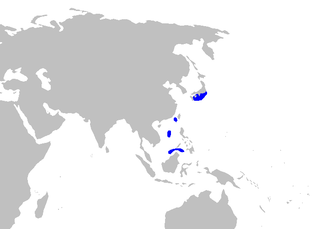
The spatulasnout catshark, also known as the Borneo catshark or flatnose catshark, is a catshark of the family Scyliorhinidae, found in the western Pacific between 35°N and 1° N. Its length is up to 80 cm.

The longnose catshark is a catshark of the family Scyliorhinidae found in the eastern central Pacific from central and southern California and the Gulf of California, between latitudes 38° N and 23° N, at depths down to 1,890. Its length is up to 58 cm.
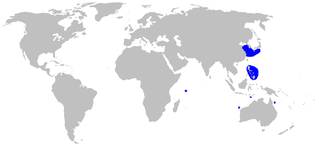
The longhead catshark or smoothbelly catshark is a species of catshark, family Scyliorhinidae, with a patchy distribution in the Indo-Pacific from Mozambique to southern Japan to northern Australia. It is found in water between 500 and 1,140 m deep. This species grows to 59 cm (23 in) long and is characterized by its extremely long and narrow snout, short abdomen, and long anal and caudal fins. In addition, a large area of the anterior ventral portion of its body lacks dermal denticles. The longhead catshark is oviparous and the only known cartilaginous fish that is normally hermaphroditic, with the majority of individuals having both the functional reproductive organs of one sex and the undeveloped reproductive organs of the opposite sex.
The sombre catshark is a species of catshark in the family Scyliorhinidae. It is known from a single specimen south of Rote Island, northwestern Australia. Its natural habitat is the open seas.
Figaro is a genus of catshark, and part of the family Scyliorhinidae. Until 2008, Figaro was generally considered to be a subgenus of Galeus. The two known species are found off Australia, inhabiting deep, offshore waters on or near the bottom. Figaro contains small, slender, firm-bodied sharks that bear distinctive crests of enlarged, spiny dermal denticles along the dorsal and ventral edges of their short caudal fins. The caudal peduncle is relatively long, such as that the anal and caudal fins are some distance apart. In adult males, the inner margins of the pelvic fins are fused together to form a subtle "apron" over the claspers. F. boardmani is a predator of fishes, crustaceans, and cephalopods, and is oviparous; less is known about the F. striatus. Both are harmless and are of no economic importance.

The spotted-belly catshark is a catshark of the family Scyliorhinidae. It is found in eastern Indonesia. This species differs from Atelomycterus baliensis in having white spots present over the body a larger first dorsal fin, paired fins closer together, and pelvic fin farther apart from the ventral caudal-fin origin. A. erdmanni differs from Atelomycterus marmoratus in having far less numerous white spotting a larger first dorsal fin, and the clasper glans about half length of clasper outer margin.


















